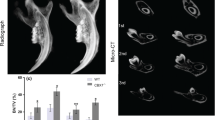Abstract
The cellular localization and roles of bone morphogenetic protein (BMP)-2 and apoptosis-associating factors in human orofacial development remain unclear. In this study, BMP-2, osteocalcin, and TGF-β, which are bone-differentiating markers, apoptosis-associating factors (i.e., Bcl-2, Bax, Fas, and Fas ligand), apoptotic cells detected by the in situ 3′-end labeling method (TUNEL), and proliferating cell nuclear antigen (PCNA) were immunohistochemically examined in the heads (in particular, the jaw bone and tooth germs) of human fetuses of 11-week pregnancy. BMP-2 was positive in osteoblasts and newly formed osteoid of the incisive and palatal bone of the maxilla and the mandible, which indicated that BMP-2 was exclusively involved in intramembranous ossification in the human fetal head. Fas was positive in the cytoplasm of osteocytes and a few osteoblasts. In contrast, Fas ligand was positive in the cytoplasm of osteoblasts and abundant in the stroma of the osteoblastic layer, periosteum, and perichondrium. The Fas ligand in the stroma was recognized as the soluble form, which was possibly produced by osteoblasts. TUNEL-positive apoptotic cells were found in a few osteocytes and a few osteoblastic cells in new bone, and in monocytes of degenerate Meckel's cartilage. The induction of apoptosis observed in monocytes seems to be caused via a Fas-Fas ligand cell death system, because some of these monocytes were Fas-positive, and most of them were Fas ligand-positive. Interestingly, the abundant soluble Fas ligand observed in the periosteum probably protects the bone-formative zone from the invasion of the activated lymphocytes by binding to Fas expressing in these lymphocytes and killing these cells. Fas and Fas ligand were focally positive in the dental lamina and inner enamel epithelium and cusps of the enamel organ, nevertheless, the presence of TUNEL-positive cells was very rare. Bcl-2 was clearly and Bax was weakly positive in the cells throughout the dental lamina and enamel organ. These findings indicated that Fas-mediated apoptosis was inhibited by the Bcl-2 family in the development of teeth.
Similar content being viewed by others
Author information
Authors and Affiliations
Additional information
Received: 22 January 1998 / Accepted: 2 December 1999
Rights and permissions
About this article
Cite this article
Hatakeyama, S., Tomichi, N., Ohara-Nemoto, Y. et al. The Immunohistochemical Localization of Fas and Fas Ligand in Jaw Bone and Tooth Germ of Human Fetuses. Calcif Tissue Int 66, 330–337 (2000). https://doi.org/10.1007/s002230010069
Published:
Issue Date:
DOI: https://doi.org/10.1007/s002230010069




